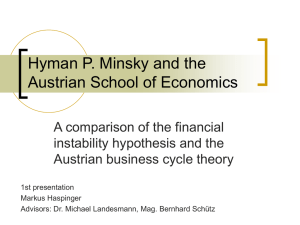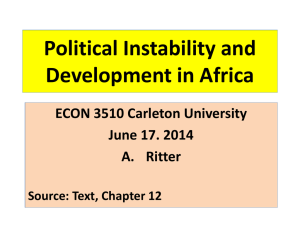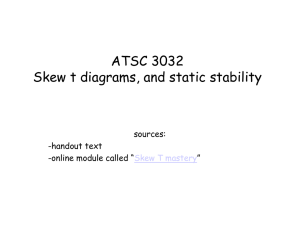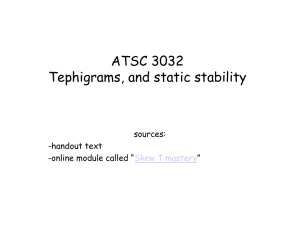Analog of Astrophysical Magnetorotational Instability in a Couette
advertisement
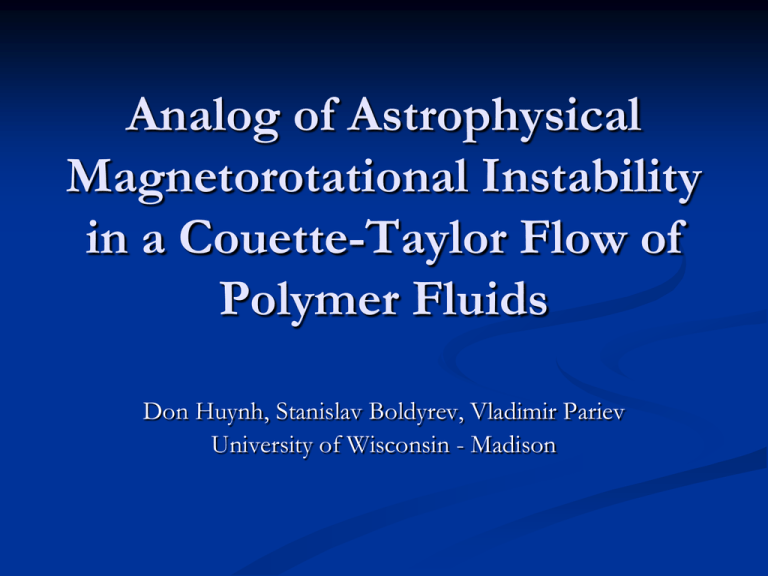
Analog of Astrophysical Magnetorotational Instability in a Couette-Taylor Flow of Polymer Fluids Don Huynh, Stanislav Boldyrev, Vladimir Pariev University of Wisconsin - Madison Acknowledgements Mark Anderson Riccardo Bonazza Cary Forest Michael Graham Daniel Klingenberg 2 Mechanical Analog of MRI Two particles in different orbital radii connected by a weak spring The particle at the smaller radius is moving at a faster velocity than the particle at the larger radius This causes the spring to stretch Since the spring wants to restore equilibrium it slows the particle at the smaller radius down while speeds up the particle at larger radius The particle at smaller radius falls into a lower orbit and the particle at larger radius moves into a higher orbit, which further stretches the spring Leads to instability 3 Magnetorotational Instability Two fluid elements connected by magnetic field lines Magnetic field lines act as the spring Elastic polymer act as magnetic field 4 Comparison of MHD and Viscoelastic Fluid Equations MHD Momentum Equation ( u t u u ) pM TM 2 u TM BB 0 B2 2 0 I Viscoelastic Fluid Momentum Equation ( u t u u ) pP TP 2 u 5 Comparison of MHD and Polymer Solution Equations From the induction equation and the Oldroyd-B constitutive equation, Tm and Tp satisfy the following equations, Tm u Tm ( u ) Tm Tm u T t Tp u Tp ( u ) Tp Tp u T t 0 1 [ B B ( B ) B ] (Tp 2 2 p I) If η → 0 and τ → ∞, one can neglect the dissipation terms 6 Narrow Gap Solution In the limit of a narrow gap (ΔR/R << 1) cylindrical Couette flow is equivalent to a plane Couette flow (linear shear flow) in a rotating channel Ogilvie and Proctor (2003) 7 Basic Flow The basic flow is the plane Couette flow: u 2 Axy De 0 1 The polymeric stress is Tp p De 2 De 2 1 0 0 1 0 and can be represented using three auxiliary fields Tp B1 B1 B2 B2 B3 B3 1 0 1 1 0 p 12 0 p 2 B1,2 ( ) De ( De 2 1) 2 , B3 ( ) 0 1 0 Ogilvie and Proctor (2003) 8 Linear Perturbations u(r , t ) u0 ( x) Re[u( x)est ikyyikzz ] T T0 Re[t ( x)e st ikyy ikzz ] (1) u x ' ik y u y ik z u z 0 (2) [( s 2iAxk y )u x 2u y p ' t xx ' ik y t xy ik z t xz (u x " k 2u x ) (3) [( s 2iAxk y )u y 2( A)u x ik y p t xy ' ik y t yy ik z t yz (u y " k 2u y ) (4) [( s 2iAxk y )u z ik z p t xz ' ik y t yz ik z t zz (u z " k 2u z ) (5) t xx [( s 2iAxk y )t xx 2iT0 xy k y u x ] 2 p u x ' (6) t xy [( s 2iAxk y )t xy 2 At xx T0 xy (u x ' ik y u y ) iT0 yy k y u x ] p (u y ' ik y u x ) (7) t xz [( s 2iAxk y )t xz iT0 xy k y u z ] p (u z ' ik z u x ) (8) t yy [( s 2iAxk y )t yy 4 At xy 2T0 xy u y ' 2iT0 yy k y u y ] 2i p k y u y (9) t yz [( s 2iAxk y )t yz 2 At xz T0 xy u z ' iT0 yy k y u z ] i p (k z u z k z u y ) (10) t zz [( s 2iAxk y )t zz ] 2i p k z u z 9 “Elasto-Rotational” Instability Consider unsheared (“axisymmetic”) modes (ky = 0) and WKB approximation with solutions of the form ux α sin(k xx) [qs (q p )(kx2 kz2 )]2 (kx2 kz2 ) 4( A)q2kz2 4A pkz2 (kx2 kz2 ) 0 Instability first appears at a stationary bifurcation (s = 0) ( p )2 (kx2 kz2 )3 4( A)kz2 4A p kz2 (kx2 kz2 ) 0 r d A A For a Keplerian profile ( r ), the Rossby number ( Ro , where 2 dr 3 2 is Oort’s first constant ) is ¾ => A = ¾Ω ( p )2 (kx2 kz2 )3 c2kz2 3c2 p kz2 (kx2 kz2 ) 0 c2 ( p )2 (k x2 k z2 )3 k z2 [3 p (k x2 k z2 ) 1] 10 “Elasto-Rotational” Instability In the limit of τ→∞ with kz2 >> kx2 the dispersion relation for the onset of 2 4 2 instability is p kz 4( A) 4A p kz 0 0 p If we identify B , the critical angular velocity is identical to the 2 z ideal MHD case for a magnetic field along the z-axis. 11 Experimental Setup Two concentric cylinders are attached to a motor on different gear ratios to rotate at different angular velocities Filled between the two cylinders is a polymer solution 12 Experiment continued m = 0 mode Want to see how the polymer behaves under Keplerian angular velocity profile Reflective particles added to visualize the fluid flow Instability can be easily seen 13 Results onset of instability agrees qualitatively with computations when sign of ∂Ω/∂r was reversed no instability detected suggests instability observed is different from purely elastic instability Keplerian profile => r12Ω1 < r22Ω2 Rayleigh’s inertial instability requires r12Ω1 > r22Ω2 so observed instability is different Phys. Rev. E 80, 066310 (2009) 14 Numerical Simulations Work in progress Try to use results to find an ideal polymer to use 15 Conclusion There is a close analogy between an electrically conducting fluid containing a magnetic field and a viscoelastic fluid The instability observed are different from purely elastic instability and Rayleigh’s inertial instability This instability is analogous to the MRI of a vertical magnetic field and can be used to study MRI in a lab setting. 16



